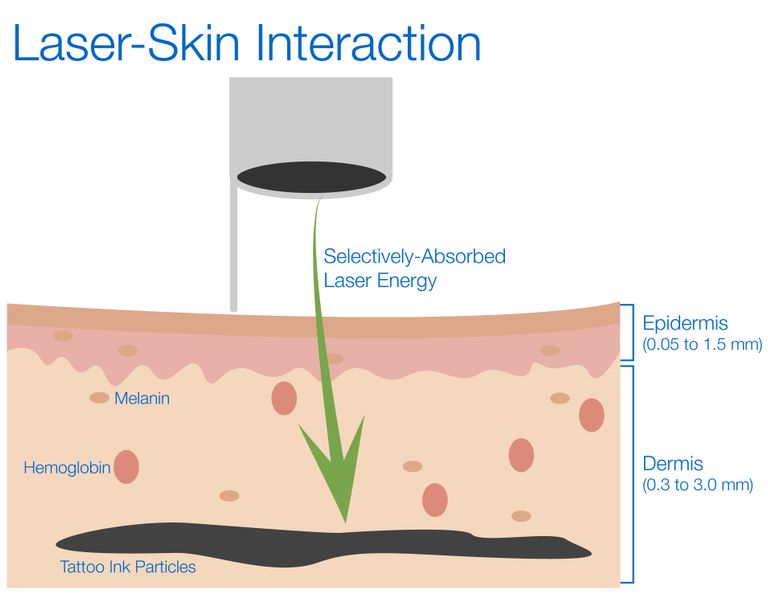How Does Laser Tattoo Removal Work???

Shattering The Ink.
During a laser tattoo removal procedure, the practitioner guides a laser over the area of the tattoo.
Unlike a laser pointer that produces a continuous beam of light, tattoo removal lasers produce pulses of light energy.
Each pulse of energy penetrates the skin and is absorbed by the tattoo ink.
As the tattoo ink particles absorb the energy, they heat up and then shatter into tiny fragments.
Then, over the weeks following treatment, the body’s immune system flushes the tattoo ink particles away from the location, lightening the appearance of the tattoo.
Each laser treatment breaks down more and more of the tattoo ink until none remains.
FREQUENTLY ASKED QUESTIONS
Does Laser Tattoo Removal Hurt?
Rest easy — while laser tattoo removal can hurt, chances are it won't hurt as much as getting the tattoo did. Tattoo removal pain is comparable to the pain of a bad sunburn, and the laser pulses feel like a rubber band snapping against your skin. Uncomfortable, yes, but tolerable.
If during your patch test you decide you don't like the feeling, clients are able to use numbing cream to completely numb the treated area, therefore feeling nothing during treatment!
Please ask at the clinic if this is of interest!!
How Many Session Will I Need?
Tattoo removal is not an instant fix – it’s usually a several-month commitment for patients. Most tattoos require anywhere between 4 and 10 treatments to achieve complete removal, and the treatments must be spaced out at least 6 weeks apart.
Laser tattoo removal requires multiple treatments because not all of the tattoo ink can be shattered in one treatment session. When a tattoo is applied, the ink is injected at different depths within the dermis.
As the laser light is applied to the skin, the shallowest layers of ink in the dermis absorb the energy and shatter, but the deeper layers may not have been affected.
Only once the body flushes away the top layers of ink can the deeper layers get treated. In effect, every successive tattoo removal treatment affects deeper and deeper layers of ink until none remains.
Why So Long Between Treatments??
Patients need to wait between treatments because it takes time for the body to flush away the shattered tattoo ink from the location of the tattoo.
The process of flushing away the ink involves immune system phagocytic cells gradually moving the ink particles to the lymph nodes, where the pigments remain.
Because the body can only flush away the ink at a certain speed, it’s beneficial to wait as long as possible between treatments to see maximum fading from each session.
Also, the waiting period allows any scabs or blisters to heal, minimizing the possibility of over-treating the area and causing unwanted side effects.
Can I remove section of a Tattoo??
Yes, of course!! If you have a section of a sleeve, or a name on a back piece that you no longer want, we can remove just that section!! Pop in or send us a pic and we can discuss how we will remove it!
Can I Have my Tattoo faded for a Cover up??
Yes definitely. We can fade a previous tattoo so you can get it covered. We share our premises with a Top class tattooist, who can help and advise how much fading will be required before cover up is achieved! Get in touch to discuss!!
Why Do I Need A Patch Test?
Each patient needs to come and have a full medical consultation and patch test before treatment begins. A patch test is just 3 shots of the laser on the tattooed area. We then leave this for at least 48hrs, just to ensure your body does not have an allergic reaction to the broken down tattoo ink! Better Safe than sorry!!!!
How Long Does A Treatment Last?
A single treatment can last anywhere from 2 minutes to 45minutes, depending on the size of the area being treated. In general, a removal sitting is the fraction of the time the original tattoo would have taken.
We need your consent to load the translations
We use a third-party service to translate the website content that may collect data about your activity. Please review the details and accept the service to view the translations.

